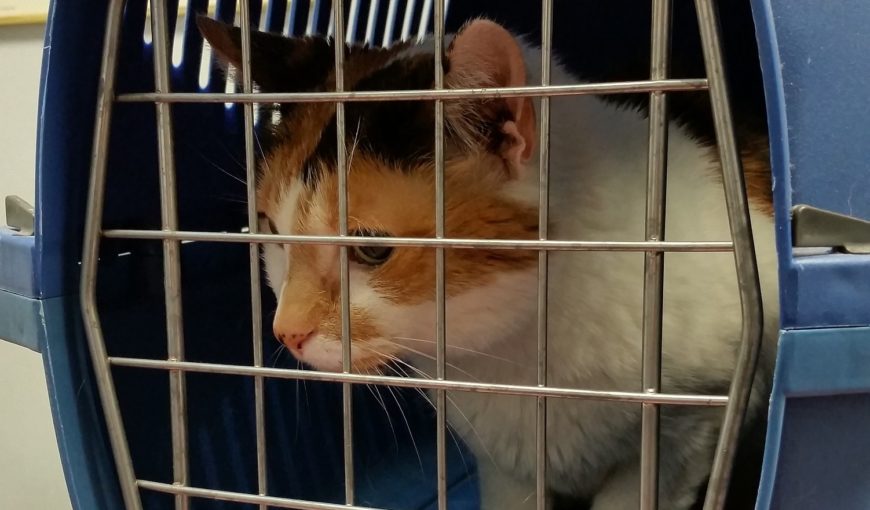Kitties and Carriers

We always recommend that you bring your kitty to the hospital in a carrier! There are many types available from plastic top or front loading to soft sided carriers. We have cardboard carriers available for purchase here at the hospital. A carrier is important for your cat’s safety and also for ours. In the event of a sudden stop during the car ride to or from the clinic, they cannot become dangerous projectiles if they are riding in a carrier. They are also less of a distraction to the driver and won’t become entangled in the pedals. You won’t have to worry about a panicked response from your friend while walking to or from the clinic. There have been multiple times where someone has lost a cat while leaving the clinic or had to cancel the appointment because we could not get the cat out from under a car seat. There is also a chance that a kitty not in a carrier could be frightened or injured by a canine patient.
The carrier should be left out at all times at home, or at least brought out a week before the appointment. The top can be removed and used as a pet bed or a play house. Most cats are very inquisitive and like to explore, so, make the carrier fun by placing treats, catnip, or toys inside. You can also make the carrier a normal part of the environment by feeding the cat in or around the carrier, and you can help them get used to it by rubbing the cat with a towel, and then putting the towel inside the carrier to fill it with the cat’s scent. Feliway, a synthetic “happy cat” pheromone, is commercially available and may help with the cat getting used to the carrier. It comes as a spray or a plug in. The spray can be applied to a towel, and then the towel can be placed in the carrier. Just be sure to let the towel air out and dry a little before adding the cat. J
Consider taking your cat on short trips to help them get used to the car. If every time they go into the carrier and then in the car, they end up at the vet and get a shot, there is no wonder they run and hide every time they see it. Going on fun car trips works better when started as a kitten, but, if your pet is already scared of the car or carrier, it is important to take baby steps, and break the process down into stages to help them get used to it. You can start by just taking your cat, in its carrier, to the car, but not going anywhere. It can also help to put the cat in the carrier, take the carrier to the car, and then feed the cat while in the carrier in the car, so it associates both the carrier and the vehicle with good things. Going on short trips with your cat in the carrier…not just to the vet…will help your cat realize that a road trip does not always lead to a scary destination and a shot. Whenever you notice your cat becoming anxious while exposing them to something, take two steps back and start the exposures again from a point where your pet was not frightened. We never want to yell at or chase them—this undermines what we are trying to accomplish.
When choosing a carrier there are some features to consider. The top half should be easily. removable. This enables the doctor to examine your cat inside the bottom half, without having to “shake the kitty” out of the main door and onto the exam table. Having doors on the top and the side also makes loading and unloading the kitty easier. Top-loading cat carriers are especially useful for larger cats. The carrier should be well-ventilated but should have more solid sides which reduces frightening visual stimulus while the cat travels. You can also cover the top and sides to provide a safe, dim interior. Lastly, the carrier should be waterproof since some frightened kitties can have an accident during travel.
If you have any questions about helping your cat acclimate to its carrier, don’t hesitate to call the Hospital at 824-4108.





